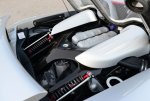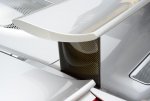- Sep 1, 2005
- 704
OWNER REVIEW: FORD GT vs. PORSCHE CARRERA GT. Part 1 of 4

As a wise man once said, “I've spent a bunch of money on cars. The rest has been wasted.” With that truism ringing in my head, I was recently fortunate to find an immaculate and virtually new Porsche Carrera GT. I bought the car from Shelby Smith (Elite Autos) whom most of us here know as an A+ purveyor of spotless GTs and other desirable exotics. The CGT is a car that has always fascinated me, but I was intimidated by its nosebleed price. When it became obvious that the cars were not getting any cheaper, compounded with the fact that this particular example came from the careful and very selective Shelby, I took the plunge. I have now driven it nearly one thousand miles. I warn the good reader in advance that this self-indulgent, vocabulary intensive review may result in a serious case of MEGO (scientific acronym for My Eyes Glazed Over). Remember, no one is forcing you to read this; if you hate all the talk, just nod and look at the pretty pictures.
Obviously, most of you know that this is not my first comparative review of the GT. This one, however, focuses on a contender that swings a very big stick…and in this case it’s made of carbon fiber. My standard pledge applies: I’ll try to be as honest and fair as I know how to be.
Intro: The Porsche Carrera GT

Full disclosure: I have a fondness for Porsches, and the Carrera GT is my sixth car from the elves in Stuttgart. I presently have a 2013 Carrera 4S (7 speed manual) that is pure bliss to drive. My first real sports car was a 1984 911 Carrera, which I owned in college, and it sparked a long-term romance with these German icons. It also formed a foundation for how I judge and interpret the subsequent sports cars I have owned.
Ah, the lovely Carrera GT. Based on an aborted Le Mans effort, the body and structural monocoque is made almost entirely of carbon fiber. No cosmetic touches of carbon here, like the laughable $12,000 "carbon package" on the dash of my Ferrari 458. The car sports a pushrod suspension and inboard mounted shock absorbers, which is incredibly cool for a street car. The engine is a 5.7 Liter V-10, which was allegedly developed for Formula 1. The engine was then shelved for later use in either the Le Mans project, or as it turned out, for a limited run super car. Porsche built the CGT in very limited numbers: 1200 or so were assembled, and only half that number came to 'merica. Until I bought mine, I don't think I’d ever actually seen one on the road. Produced at the same time as the Ford GT, the Carrera GT is also among the last of the true analogue supercars, with a manual transmission and relatively limited computer intervention.
Porsche did not name the Carrera GT by coincidence; it has obvious genetic ties to the revered 911 Carrera, including iconic design elements (the nose for example) and the intimacy of the interior and driving position. The car has a shallow dash, and the windscreen is relatively close to the driver. The moment you sit in the car, the bottom-hinged pedals, the design of the gauge cluster, and the placement of the wheel tell you that you’re in a Porsche. It’s just all about ten times more intense. Imagine taking three or four recent 911s, say, a turbo, a C2S, a 4.0 RS, and maybe even a GT3 Cup car. Further imagine putting these cars into a magical pressing device, and compacting them until a few tiny drops of highly enriched Teutonic mojo drips out the bottom. This is what the CGT is made of. For crying out loud, the whole car is made of carbon fiber, and then they strapped this manic, howling F1-derived V10 into the back of it.
Intro: The Ford GT (for Neophytes)

Ford built the GT to commemorate Ford's 100th anniversary, and production ran only in 2005 and 2006. During that time, just over 4000 were built. The car is based on the original GT40, variations of which famously dominated Le Mans from 1966-1969. Since production ended, the cars have been increasing in value and are widely recognized as a highly collectible modern exotic. A low mile Heritage car (Gulf themed, blue and orange) recently sold, including buyer’s commission, for over $400,000. The GT boasts a wonderfully robust 5.4-liter, dual overhead cam V8 set under a super trick rear clamshell that opens to expose the entire power plant and rear structure of the car. In my humble opinion, the GT has one of the greatest American V8s ever built, and is capable of incredible feats of horsepower when modified. The Ford GT is unlike anything America has ever produced, with the obvious exception of the original GT40. It is the personification of American exuberance, amazing engineering prowess, inspired design, and just a touch of over-the-top excess. I seldom, if ever, see one on the road. It seems that they are becoming more rare as they are either crashed, exported overseas, or closeted away in private collections.
THE OVERALL DRIVING EXPERIENCE
I remember the first time I ever drove a GT. I said to myself “Self, this car is surprisingly docile and easy to drive”. When I first drove the CGT, I said to myself, “Self, this thing is surprisingly violent and difficult to drive”. First impressions aren’t always right, but in this case, they were. Let me explain.

That #$%@ Clutch!
Let’s get this out of the way first. Most of you have probably heard reference to the CGT’s notorious clutch. It’s a tiny little multi plate affair made of carbon something. It weighs about as much as a pop tart. There is good news here and bad news. First the good: the clutch is quite ordinary and even pleasant to use while the car is in motion (i.e. gears 2-6). The bad news: 1st gear (and only from a dead stop), requires a special procedure that no other car demands. Imagine you are sitting at a stop light in heavy traffic. You are first at the line, because you got there first, just like a sport bike. The light turns green. Your instinct is to feather the throttle downward as you release the clutch, and leave the line smoothly. Bomp. The car bucks and then stalls! You curse. Your face turns red. You fumble. You cast a steely eye toward heaven. The Camry behind you almost tags you in the rump. Your next instinct is to fire the engine, give it even more throttle, and slip the clutch out. If you do this, the clutch will engage like an on/off switch, and you will lurch away from the line with all the grace of a 15 year-old with a learner’s permit. This, I am told, is the reason people burn their CGT clutch up in a few thousand miles and get to pay the price of a nice used car to have it replaced.
The proper method is simple but painfully counterintuitive: keep your foot away from the throttle, release the clutch slowly, and allow the anti-stall software to bump the revs as the car gets rolling. As soon as you are moving, you apply throttle and it’s all quite smooth. But boy, does it feel slow. If you live way out in the country like I do, it doesn’t matter how quickly you leave a dead stop, and it is an absolute no brainer to drive. Heavy urban traffic, however, is another story. One little trick is to time your start in advance of the green light, or to come to a “rolling” stop at stop signs; if the car is even moving at 2 mph, the clutch is a breeze to release. Here is a word of warning to prospective CGT owner/drivers: if you like to do hole shots out of first gear, either find a different car or buy a six pack of Tilton carbon clutches and make good friends with your banker and your service guy. I’ve tried to figure out why Porsche would sacrifice first gear drivability is such a way. All I can deduce is that they felt quick intersection departures were less important than the ultra light weight and a lower center of gravity. Hmm, sounds suspiciously like a race car. Deal breaker? Not for me. But it might be for someone else.
A Race car in Designer Clothing
This is where I should digress and make a very important point to the uninitiated: the Carrera GT is certainly not for everyone, and Porsche meant it to be that way. If you look at all the glossy marketing pictures of the CGT and imagine that it will be a velvety, smooth grand touring car like a Mercedes SL, you are utterly and laughably mistaken. The only thing that the Carrera GT has in common with an SL is that they both ride on four wheels, and the only thing that separates the Carrera GT from a full-on race car is the lack of a fuel cell and a fire suppression system. It’s no surprise that it has built-in provisions for a race harness and deeply bolstered track seats, even if they are covered in fine leather.
First, there is the gear noise. In 1st and 2nd gears, there is pronounced sound of the cogs working, and in any gear, at about 2000 rpm, there is a rattlesnake resonance that is quite evident. Where it comes from, I don’t know, but it feels like it’s in the transaxle. Then there’s the ride, which is transparently communicative of virtually every road imperfection, no matter how tiny. The carbon monocoque has absolutely no flex. Accordingly, every ripple in the road is translated quite accurately through the super sensitive steering and the push rod suspension. As my Dad would say, you could drive over a dime in the CGT and tell the date stamped on it. The road noise is always there too, seemingly amplified by the chassis, and if your ears miss the sound of a every single freeway expansion joint, your bung-o-meter will be happy to send you the memo. Finally, there is the aforementioned race car clutch, the race car acceleration (more on that later) and the light rotational mass of the engine (later too).
I can certainly imagine that there were at least a few gold Rolex-toting trophy hunters back in ‘05 who bought the CGT, stalled it a few times, crashed it over a speed bump or two, and then escorted it quietly away, like the vulgar cousin who showed up unannounced for tea and crumpets. This is a hairy chested sports car, plain and simple, and I love it. It’s almost as if the design team said, “okay, if we don’t have to mass market this thing and keep a wide range of potential buyers happy, let’s do it the way we would if the marketeers weren’t looking.”
The engineers got the details right in so many ways. The outward visibility is pure 911 magic, with an unobstructed view of the road. I love the way this car feels from the driver’s seat, even when it’s not in motion. I don’t think it has an equal in this regard, except maybe my inimitable Zanardi NSX. When you reach to the left of the steering column and twist the ignition, the tiny starter motor whirls like a LMP car and the V10 sparks to life immediately, at a high idle. From the first moment, this car tells you that it is looking for adventure. A Camry it is not.
The Ford GT

Moving from the Porsche to the GT, one is immediately struck by the exuberant and historically inspired design of the car, including the cockpit. The GT interior feels more airy than the Porsche, which is usually the case when comparing our big American cars made for big American roads and big American bottoms against small European cars made for small European roads. The outward view of the GT, however, is somewhat more pinched than that of the CGT, and the thick A pillars are significantly more present than those of the Porsche. However, I have never sat in the GT in isolation and thought it was hard to see out of. Nor have I felt a lack of confidence about where the car is in a corner; the outward visibility simply feels different and slightly less open by comparison. The ergonomics of the GT are fantastic; the shift lever is right where you want it, the pedals are easy to manipulate, and the long row of gauges are an aesthetic and functional homerun. True to the Le Mans heritage, the speedo is to the far right, canted toward the driver.
Press the red blast-off button, and the big V8 (ironically about 300cc smaller than the Porsche’s V10) lights with a bark and then a rumble, and you are back home in the U S of A. Or maybe at Le Mans in 1966. Pull out of the neighborhood and let the fireworks begin. The clutch, of course, is a dream of simplicity compared to the Porsche. In this regard, the Ford seems like your most loyal bird dog or maybe your best buddy; you just know what he’s gonna do every time, under fire or not. The GT is no more difficult to drive than a V8 Mustang. It’s just that this particular Ford is capable of blistering the tarmac at 212 MPH and looks like it could have just pulled off the Mulsanne straight. What’s amazing is that the athletic GT can do all of this and more, yet it remains drama free. The driving experience is silky in comparison to the CGT. I am surprised that I can write that and still feel like I’m telling the truth. But I am.
A NOTE TO MY GT BRETHREN: This review is so enormous that I have to break it up into multiple posts. I've completed the entire review, but to keep you all on the very edge of your seats, I'll post these up in serial fashion. Next time, I will thrill you with my wit regarding the V10 vs. V8!

As a wise man once said, “I've spent a bunch of money on cars. The rest has been wasted.” With that truism ringing in my head, I was recently fortunate to find an immaculate and virtually new Porsche Carrera GT. I bought the car from Shelby Smith (Elite Autos) whom most of us here know as an A+ purveyor of spotless GTs and other desirable exotics. The CGT is a car that has always fascinated me, but I was intimidated by its nosebleed price. When it became obvious that the cars were not getting any cheaper, compounded with the fact that this particular example came from the careful and very selective Shelby, I took the plunge. I have now driven it nearly one thousand miles. I warn the good reader in advance that this self-indulgent, vocabulary intensive review may result in a serious case of MEGO (scientific acronym for My Eyes Glazed Over). Remember, no one is forcing you to read this; if you hate all the talk, just nod and look at the pretty pictures.
Obviously, most of you know that this is not my first comparative review of the GT. This one, however, focuses on a contender that swings a very big stick…and in this case it’s made of carbon fiber. My standard pledge applies: I’ll try to be as honest and fair as I know how to be.
Intro: The Porsche Carrera GT

Full disclosure: I have a fondness for Porsches, and the Carrera GT is my sixth car from the elves in Stuttgart. I presently have a 2013 Carrera 4S (7 speed manual) that is pure bliss to drive. My first real sports car was a 1984 911 Carrera, which I owned in college, and it sparked a long-term romance with these German icons. It also formed a foundation for how I judge and interpret the subsequent sports cars I have owned.
Ah, the lovely Carrera GT. Based on an aborted Le Mans effort, the body and structural monocoque is made almost entirely of carbon fiber. No cosmetic touches of carbon here, like the laughable $12,000 "carbon package" on the dash of my Ferrari 458. The car sports a pushrod suspension and inboard mounted shock absorbers, which is incredibly cool for a street car. The engine is a 5.7 Liter V-10, which was allegedly developed for Formula 1. The engine was then shelved for later use in either the Le Mans project, or as it turned out, for a limited run super car. Porsche built the CGT in very limited numbers: 1200 or so were assembled, and only half that number came to 'merica. Until I bought mine, I don't think I’d ever actually seen one on the road. Produced at the same time as the Ford GT, the Carrera GT is also among the last of the true analogue supercars, with a manual transmission and relatively limited computer intervention.
Porsche did not name the Carrera GT by coincidence; it has obvious genetic ties to the revered 911 Carrera, including iconic design elements (the nose for example) and the intimacy of the interior and driving position. The car has a shallow dash, and the windscreen is relatively close to the driver. The moment you sit in the car, the bottom-hinged pedals, the design of the gauge cluster, and the placement of the wheel tell you that you’re in a Porsche. It’s just all about ten times more intense. Imagine taking three or four recent 911s, say, a turbo, a C2S, a 4.0 RS, and maybe even a GT3 Cup car. Further imagine putting these cars into a magical pressing device, and compacting them until a few tiny drops of highly enriched Teutonic mojo drips out the bottom. This is what the CGT is made of. For crying out loud, the whole car is made of carbon fiber, and then they strapped this manic, howling F1-derived V10 into the back of it.
Intro: The Ford GT (for Neophytes)

Ford built the GT to commemorate Ford's 100th anniversary, and production ran only in 2005 and 2006. During that time, just over 4000 were built. The car is based on the original GT40, variations of which famously dominated Le Mans from 1966-1969. Since production ended, the cars have been increasing in value and are widely recognized as a highly collectible modern exotic. A low mile Heritage car (Gulf themed, blue and orange) recently sold, including buyer’s commission, for over $400,000. The GT boasts a wonderfully robust 5.4-liter, dual overhead cam V8 set under a super trick rear clamshell that opens to expose the entire power plant and rear structure of the car. In my humble opinion, the GT has one of the greatest American V8s ever built, and is capable of incredible feats of horsepower when modified. The Ford GT is unlike anything America has ever produced, with the obvious exception of the original GT40. It is the personification of American exuberance, amazing engineering prowess, inspired design, and just a touch of over-the-top excess. I seldom, if ever, see one on the road. It seems that they are becoming more rare as they are either crashed, exported overseas, or closeted away in private collections.
THE OVERALL DRIVING EXPERIENCE
I remember the first time I ever drove a GT. I said to myself “Self, this car is surprisingly docile and easy to drive”. When I first drove the CGT, I said to myself, “Self, this thing is surprisingly violent and difficult to drive”. First impressions aren’t always right, but in this case, they were. Let me explain.

That #$%@ Clutch!
Let’s get this out of the way first. Most of you have probably heard reference to the CGT’s notorious clutch. It’s a tiny little multi plate affair made of carbon something. It weighs about as much as a pop tart. There is good news here and bad news. First the good: the clutch is quite ordinary and even pleasant to use while the car is in motion (i.e. gears 2-6). The bad news: 1st gear (and only from a dead stop), requires a special procedure that no other car demands. Imagine you are sitting at a stop light in heavy traffic. You are first at the line, because you got there first, just like a sport bike. The light turns green. Your instinct is to feather the throttle downward as you release the clutch, and leave the line smoothly. Bomp. The car bucks and then stalls! You curse. Your face turns red. You fumble. You cast a steely eye toward heaven. The Camry behind you almost tags you in the rump. Your next instinct is to fire the engine, give it even more throttle, and slip the clutch out. If you do this, the clutch will engage like an on/off switch, and you will lurch away from the line with all the grace of a 15 year-old with a learner’s permit. This, I am told, is the reason people burn their CGT clutch up in a few thousand miles and get to pay the price of a nice used car to have it replaced.
The proper method is simple but painfully counterintuitive: keep your foot away from the throttle, release the clutch slowly, and allow the anti-stall software to bump the revs as the car gets rolling. As soon as you are moving, you apply throttle and it’s all quite smooth. But boy, does it feel slow. If you live way out in the country like I do, it doesn’t matter how quickly you leave a dead stop, and it is an absolute no brainer to drive. Heavy urban traffic, however, is another story. One little trick is to time your start in advance of the green light, or to come to a “rolling” stop at stop signs; if the car is even moving at 2 mph, the clutch is a breeze to release. Here is a word of warning to prospective CGT owner/drivers: if you like to do hole shots out of first gear, either find a different car or buy a six pack of Tilton carbon clutches and make good friends with your banker and your service guy. I’ve tried to figure out why Porsche would sacrifice first gear drivability is such a way. All I can deduce is that they felt quick intersection departures were less important than the ultra light weight and a lower center of gravity. Hmm, sounds suspiciously like a race car. Deal breaker? Not for me. But it might be for someone else.
A Race car in Designer Clothing
This is where I should digress and make a very important point to the uninitiated: the Carrera GT is certainly not for everyone, and Porsche meant it to be that way. If you look at all the glossy marketing pictures of the CGT and imagine that it will be a velvety, smooth grand touring car like a Mercedes SL, you are utterly and laughably mistaken. The only thing that the Carrera GT has in common with an SL is that they both ride on four wheels, and the only thing that separates the Carrera GT from a full-on race car is the lack of a fuel cell and a fire suppression system. It’s no surprise that it has built-in provisions for a race harness and deeply bolstered track seats, even if they are covered in fine leather.
First, there is the gear noise. In 1st and 2nd gears, there is pronounced sound of the cogs working, and in any gear, at about 2000 rpm, there is a rattlesnake resonance that is quite evident. Where it comes from, I don’t know, but it feels like it’s in the transaxle. Then there’s the ride, which is transparently communicative of virtually every road imperfection, no matter how tiny. The carbon monocoque has absolutely no flex. Accordingly, every ripple in the road is translated quite accurately through the super sensitive steering and the push rod suspension. As my Dad would say, you could drive over a dime in the CGT and tell the date stamped on it. The road noise is always there too, seemingly amplified by the chassis, and if your ears miss the sound of a every single freeway expansion joint, your bung-o-meter will be happy to send you the memo. Finally, there is the aforementioned race car clutch, the race car acceleration (more on that later) and the light rotational mass of the engine (later too).
I can certainly imagine that there were at least a few gold Rolex-toting trophy hunters back in ‘05 who bought the CGT, stalled it a few times, crashed it over a speed bump or two, and then escorted it quietly away, like the vulgar cousin who showed up unannounced for tea and crumpets. This is a hairy chested sports car, plain and simple, and I love it. It’s almost as if the design team said, “okay, if we don’t have to mass market this thing and keep a wide range of potential buyers happy, let’s do it the way we would if the marketeers weren’t looking.”
The engineers got the details right in so many ways. The outward visibility is pure 911 magic, with an unobstructed view of the road. I love the way this car feels from the driver’s seat, even when it’s not in motion. I don’t think it has an equal in this regard, except maybe my inimitable Zanardi NSX. When you reach to the left of the steering column and twist the ignition, the tiny starter motor whirls like a LMP car and the V10 sparks to life immediately, at a high idle. From the first moment, this car tells you that it is looking for adventure. A Camry it is not.
The Ford GT

Moving from the Porsche to the GT, one is immediately struck by the exuberant and historically inspired design of the car, including the cockpit. The GT interior feels more airy than the Porsche, which is usually the case when comparing our big American cars made for big American roads and big American bottoms against small European cars made for small European roads. The outward view of the GT, however, is somewhat more pinched than that of the CGT, and the thick A pillars are significantly more present than those of the Porsche. However, I have never sat in the GT in isolation and thought it was hard to see out of. Nor have I felt a lack of confidence about where the car is in a corner; the outward visibility simply feels different and slightly less open by comparison. The ergonomics of the GT are fantastic; the shift lever is right where you want it, the pedals are easy to manipulate, and the long row of gauges are an aesthetic and functional homerun. True to the Le Mans heritage, the speedo is to the far right, canted toward the driver.
Press the red blast-off button, and the big V8 (ironically about 300cc smaller than the Porsche’s V10) lights with a bark and then a rumble, and you are back home in the U S of A. Or maybe at Le Mans in 1966. Pull out of the neighborhood and let the fireworks begin. The clutch, of course, is a dream of simplicity compared to the Porsche. In this regard, the Ford seems like your most loyal bird dog or maybe your best buddy; you just know what he’s gonna do every time, under fire or not. The GT is no more difficult to drive than a V8 Mustang. It’s just that this particular Ford is capable of blistering the tarmac at 212 MPH and looks like it could have just pulled off the Mulsanne straight. What’s amazing is that the athletic GT can do all of this and more, yet it remains drama free. The driving experience is silky in comparison to the CGT. I am surprised that I can write that and still feel like I’m telling the truth. But I am.
A NOTE TO MY GT BRETHREN: This review is so enormous that I have to break it up into multiple posts. I've completed the entire review, but to keep you all on the very edge of your seats, I'll post these up in serial fashion. Next time, I will thrill you with my wit regarding the V10 vs. V8!






